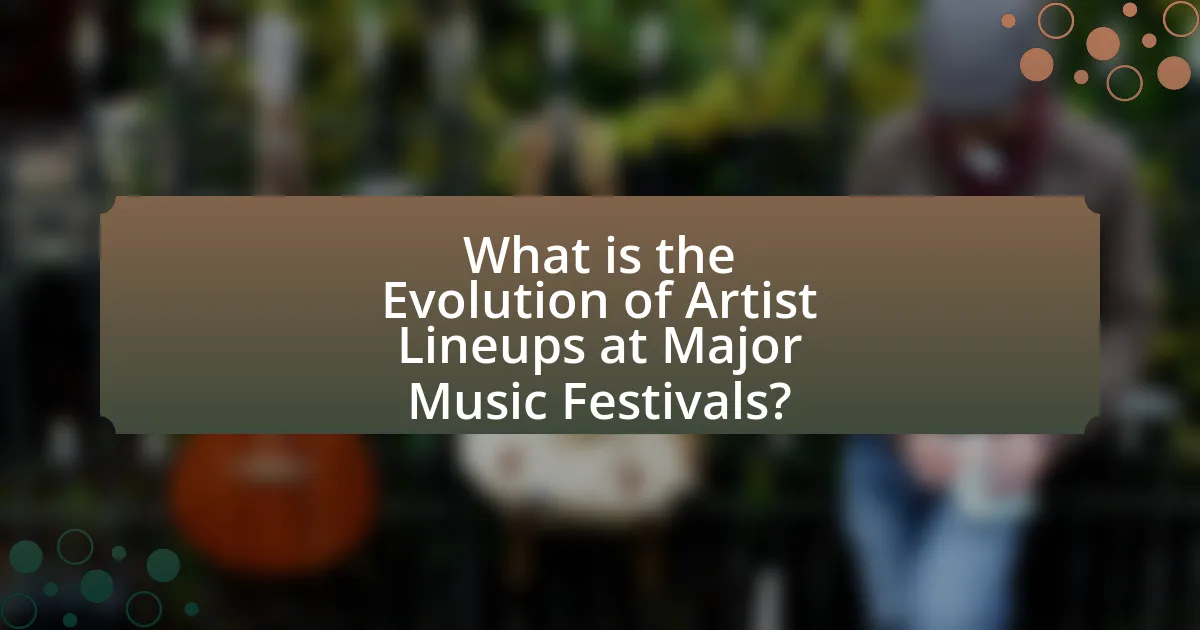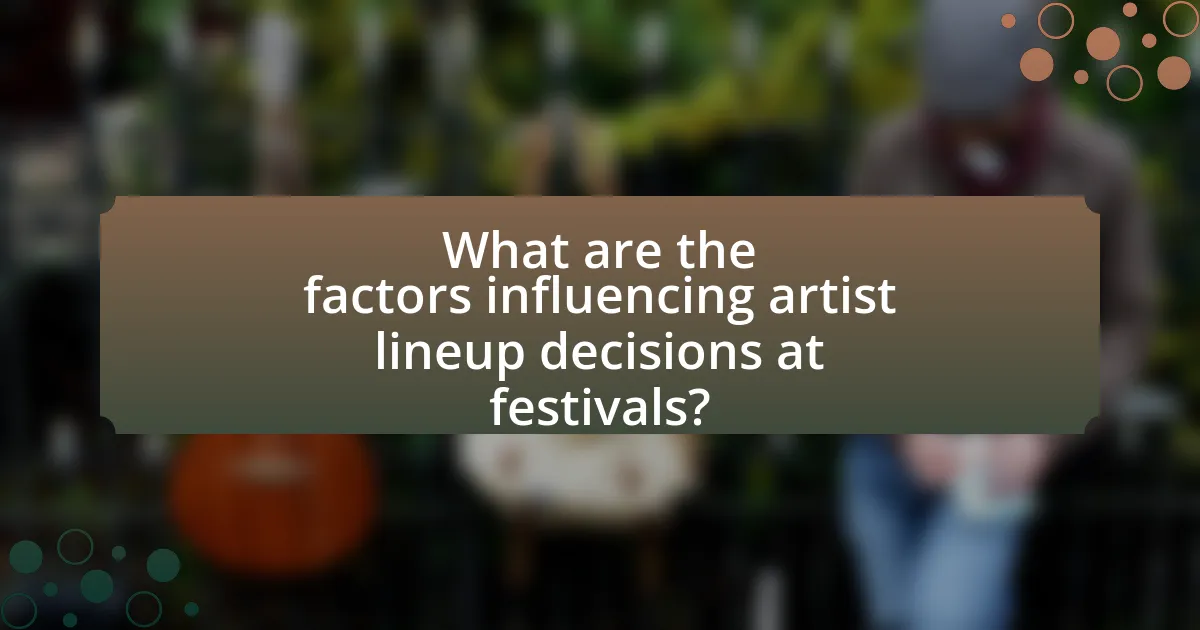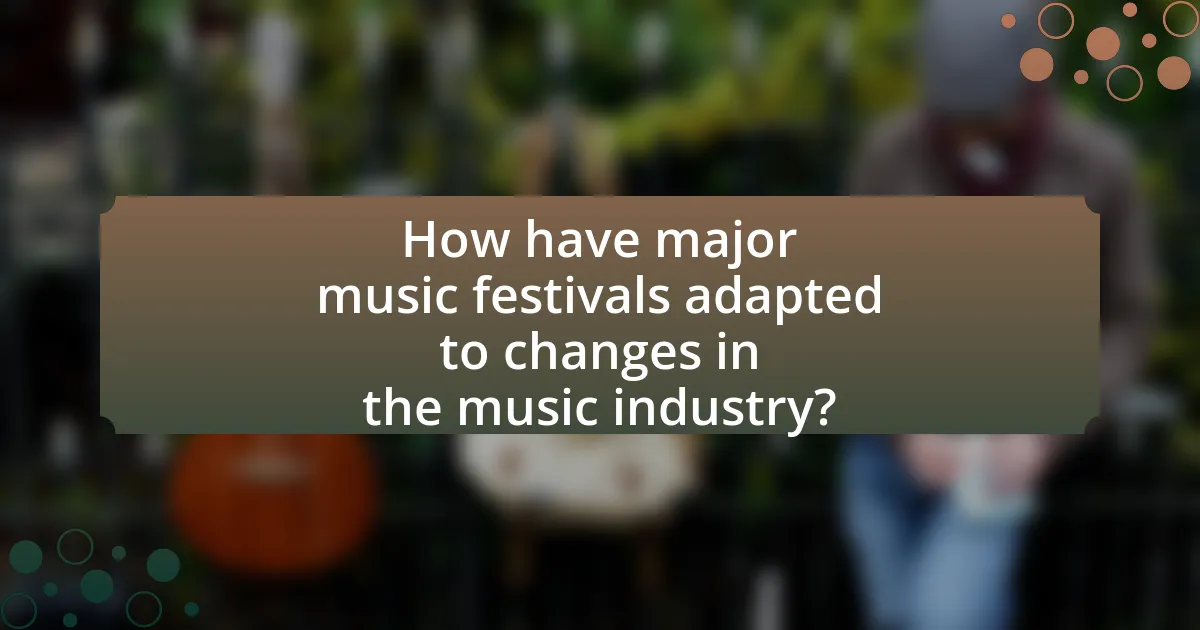The article examines the evolution of artist lineups at major music festivals, highlighting the shift from local acts to a diverse array of international superstars and emerging talent. It details how festivals like Woodstock, Coachella, and Glastonbury have adapted their lineups over the decades to reflect changing musical genres, cultural trends, and audience demographics. Key influences on artist selection, the impact of cultural shifts in the 1990s, and the significance of diversity and inclusivity in contemporary lineups are discussed. Additionally, the article explores the factors affecting lineup decisions, the role of technology and social media, and the logistical challenges faced by festival organizers in curating successful and engaging lineups.

What is the Evolution of Artist Lineups at Major Music Festivals?
The evolution of artist lineups at major music festivals has transitioned from predominantly local acts to a diverse mix of international superstars and emerging talent. In the early days of festivals, such as Woodstock in 1969, lineups featured primarily rock and folk artists, reflecting the cultural movements of the time. Over the decades, festivals like Coachella and Glastonbury have expanded their lineups to include a wide range of genres, including electronic, hip-hop, and pop, catering to a broader audience.
For instance, Coachella’s lineup in 1999 featured artists like Beck and The Chemical Brothers, while its 2022 lineup included global icons like Billie Eilish and Harry Styles, showcasing the festival’s shift towards mainstream and diverse musical styles. This evolution is also evidenced by the increasing representation of female artists and artists from various cultural backgrounds, reflecting societal changes and the push for inclusivity in the music industry.
How have artist lineups changed over the decades?
Artist lineups at major music festivals have evolved significantly over the decades, reflecting changes in musical genres, cultural trends, and audience demographics. In the 1960s and 1970s, festivals primarily featured rock and folk artists, with iconic events like Woodstock showcasing acts such as Jimi Hendrix and Janis Joplin. By the 1980s and 1990s, the inclusion of hip-hop and electronic music began to rise, with festivals like Lollapalooza introducing diverse genres and artists like Nirvana and Beastie Boys.
In the 2000s, the trend shifted towards a more eclectic mix, incorporating pop, indie, and electronic dance music, as seen in events like Coachella, which featured artists ranging from Radiohead to Beyoncé. Recent years have seen an even broader representation of genres and a focus on inclusivity, with festivals increasingly booking female artists and artists from various cultural backgrounds, reflecting societal changes and audience demands. This evolution illustrates a shift from genre-specific lineups to more diverse and inclusive representations of the current music landscape.
What were the key influences on artist selection in the early years?
Key influences on artist selection in the early years included genre popularity, cultural movements, and audience demographics. Music festivals often prioritized artists who represented the prevailing musical trends, such as rock, folk, or jazz, aligning with the tastes of the era’s youth culture. Additionally, social and political contexts, such as the counterculture movement of the 1960s, played a significant role in shaping lineups, as festivals sought to embody the spirit of social change and artistic expression. Historical examples include the Woodstock Festival in 1969, which featured artists like Jimi Hendrix and Janis Joplin, reflecting the era’s countercultural ethos and musical diversity.
How did cultural shifts impact lineup diversity in the 1990s?
Cultural shifts in the 1990s significantly enhanced lineup diversity at major music festivals. The rise of genres such as hip-hop, grunge, and alternative rock, alongside increased visibility for women and artists of color, led to a broader representation of musical styles and backgrounds. Festivals like Lollapalooza and Woodstock ’94 showcased a mix of established and emerging artists from various genres, reflecting societal changes and the demand for inclusivity. For instance, Lollapalooza featured acts like A Tribe Called Quest and the Smashing Pumpkins, illustrating the blending of different musical influences and demographics. This era marked a pivotal transition towards more diverse and inclusive lineups, driven by cultural movements advocating for representation and equality in the music industry.
Why is the evolution of artist lineups significant?
The evolution of artist lineups is significant because it reflects changing musical trends, audience preferences, and cultural shifts within the music industry. As festivals adapt to these changes, they curate lineups that not only attract diverse audiences but also showcase emerging talent alongside established acts. For instance, the Coachella Valley Music and Arts Festival has evolved its lineups over the years to include a wider range of genres and artists, which has contributed to its growth in attendance and cultural relevance. This adaptability ensures that festivals remain competitive and relevant in a rapidly changing entertainment landscape.
What does the evolution reveal about music trends and audience preferences?
The evolution of artist lineups at major music festivals reveals a shift towards diversity in genres and increased representation of underrepresented artists. This trend indicates that audiences are increasingly favoring eclectic lineups that include a mix of established and emerging artists across various musical styles. For instance, data from the Coachella festival shows a significant rise in the inclusion of female artists and artists of color over the past decade, reflecting audience preferences for inclusivity and variety. Additionally, studies indicate that festivals featuring diverse lineups tend to attract larger audiences, demonstrating that audience preferences are evolving towards a broader appreciation of different musical expressions.
How does lineup evolution reflect broader societal changes?
Lineup evolution at major music festivals reflects broader societal changes by showcasing shifts in cultural values, diversity, and musical trends. For instance, the increasing inclusion of female artists and artists from diverse backgrounds in festival lineups mirrors the growing societal emphasis on gender equality and representation. Data from the 2020 Coachella lineup indicated that female artists made up 46% of the performers, a significant increase from previous years, highlighting a shift towards inclusivity in the music industry. Additionally, the rise of genres like hip-hop and electronic dance music in festival lineups illustrates changing musical preferences and the influence of youth culture on mainstream entertainment. This evolution not only represents the changing tastes of festival-goers but also reflects broader societal movements towards diversity, equity, and the celebration of varied cultural expressions.

What are the factors influencing artist lineup decisions at festivals?
The factors influencing artist lineup decisions at festivals include audience demographics, genre diversity, budget constraints, and market trends. Audience demographics dictate the types of artists that will attract attendees, while genre diversity ensures a broader appeal and enhances the festival experience. Budget constraints limit the selection of artists based on their booking fees, which can vary significantly. Market trends, such as the popularity of certain genres or artists at a given time, also play a crucial role in lineup decisions, as festivals aim to remain relevant and competitive. For instance, festivals like Coachella and Lollapalooza often analyze ticket sales data and social media trends to inform their artist selections, ensuring they align with current audience preferences.
How do festival organizers choose artists for their lineups?
Festival organizers choose artists for their lineups based on a combination of factors including audience demand, genre representation, and market trends. They analyze ticket sales data, social media engagement, and streaming statistics to identify popular artists that resonate with their target audience. Additionally, organizers consider the festival’s brand identity and the overall experience they want to create, ensuring a diverse lineup that appeals to various demographics. Historical data shows that festivals like Coachella and Glastonbury have successfully utilized these strategies to curate lineups that attract large crowds and generate significant revenue.
What role does audience demographic play in artist selection?
Audience demographic significantly influences artist selection by ensuring that the chosen performers resonate with the target audience’s preferences and cultural background. Festivals analyze demographic data, such as age, gender, and geographic location, to curate lineups that appeal to their attendees, thereby enhancing ticket sales and overall satisfaction. For instance, a study by the International Music Summit found that festivals with lineups aligned to audience demographics experienced a 30% increase in attendance compared to those that did not consider demographic factors. This correlation underscores the importance of understanding audience demographics in the strategic planning of artist selections for music festivals.
How do sponsorships and partnerships affect lineup choices?
Sponsorships and partnerships significantly influence lineup choices by prioritizing artists who align with the brand values and marketing goals of sponsors. Major music festivals often select headliners and supporting acts based on their marketability and appeal to the target demographic of sponsors, which can lead to a more commercially viable lineup. For instance, festivals like Coachella and Lollapalooza have been known to feature artists who not only attract large audiences but also resonate with the brands sponsoring the event, such as fashion labels or beverage companies. This alignment can enhance the overall festival experience while ensuring that sponsors receive maximum visibility and engagement from attendees.
What impact do headliners have on the overall lineup?
Headliners significantly influence the overall lineup by attracting larger audiences and shaping the festival’s branding. Their presence often dictates the selection of supporting acts, as promoters aim to create a cohesive experience that aligns with the headliner’s genre and appeal. For instance, major festivals like Coachella and Lollapalooza often feature headliners that are globally recognized, which in turn elevates the visibility of lesser-known artists in the lineup, enhancing their exposure to new fans. This dynamic not only boosts ticket sales but also impacts the festival’s reputation, as a strong headliner can elevate the perceived quality of the entire event.
How do headliners influence ticket sales and festival reputation?
Headliners significantly influence ticket sales and festival reputation by attracting larger audiences and enhancing the perceived value of the event. Major artists often serve as the primary draw for attendees, with studies indicating that festivals featuring well-known headliners can see ticket sales increase by up to 50% compared to those without. Furthermore, the presence of high-profile acts elevates the festival’s status, leading to increased media coverage and social media buzz, which further enhances its reputation. For instance, festivals like Coachella and Glastonbury have built their identities around iconic headliners, solidifying their positions as premier events in the music industry.
What strategies do festivals use to balance headliners with emerging artists?
Festivals employ several strategies to balance headliners with emerging artists, primarily through curated lineups, staggered scheduling, and dedicated stages for new talent. Curated lineups allow festival organizers to strategically select a mix of well-known headliners and promising newcomers, ensuring that emerging artists gain visibility alongside established acts. Staggered scheduling helps by placing emerging artists in time slots that do not directly compete with headliners, maximizing audience exposure. Additionally, dedicated stages for emerging talent create a platform specifically for new artists, fostering discovery while maintaining the festival’s overall appeal. These strategies are supported by industry trends indicating that festivals with diverse lineups attract larger audiences and enhance the overall experience, as seen in events like Coachella and Lollapalooza, which have successfully integrated emerging artists into their programming.

How have major music festivals adapted to changes in the music industry?
Major music festivals have adapted to changes in the music industry by diversifying their artist lineups and incorporating technology to enhance the attendee experience. Festivals like Coachella and Lollapalooza now feature a mix of established artists and emerging talent, reflecting shifts in listener preferences and the rise of streaming platforms that promote new artists. Additionally, many festivals have embraced live streaming and virtual attendance options, especially during the COVID-19 pandemic, allowing them to reach a broader audience and maintain engagement despite physical attendance limitations. This adaptation is evidenced by the significant increase in online viewership for events like the virtual edition of Tomorrowland, which attracted millions of viewers globally, demonstrating the effectiveness of these strategies in responding to industry changes.
What trends are shaping the future of artist lineups?
Diversity and inclusivity are key trends shaping the future of artist lineups at major music festivals. Festivals are increasingly prioritizing a broader representation of genres, genders, and cultural backgrounds to reflect the diverse audience they serve. For instance, data from the 2022 Coachella festival revealed that 50% of the headliners were women, a significant increase from previous years, indicating a shift towards gender parity in lineup selections. Additionally, festivals are incorporating more international artists, showcasing a variety of musical styles and cultural influences, which enhances the overall experience for attendees and promotes global music appreciation.
How is technology influencing artist selection and performance?
Technology is significantly influencing artist selection and performance by enabling data-driven decision-making and enhancing live experiences. Platforms like Spotify and social media analytics provide insights into audience preferences, allowing festival organizers to curate lineups that resonate with target demographics. For instance, data from Spotify’s streaming numbers can indicate which artists are trending, leading to their selection for major festivals. Additionally, advancements in performance technology, such as augmented reality and high-quality sound systems, elevate the audience experience, making performances more engaging and memorable. This integration of technology not only shapes the artists chosen but also transforms how they present their music live, ultimately impacting the overall festival experience.
What role do social media and streaming platforms play in lineup evolution?
Social media and streaming platforms significantly influence lineup evolution by shaping audience preferences and enhancing artist visibility. These platforms allow fans to engage with artists directly, leading to increased demand for specific performers at music festivals. For instance, data from a 2021 survey by Eventbrite indicated that 70% of festival-goers discover new artists through social media, demonstrating its impact on lineup decisions. Additionally, streaming services like Spotify and Apple Music provide analytics on listener trends, enabling festival organizers to curate lineups that align with current musical tastes, thus ensuring higher attendance and engagement.
What challenges do festivals face in curating artist lineups?
Festivals face several challenges in curating artist lineups, primarily including budget constraints, artist availability, and audience expectations. Budget constraints limit the number and caliber of artists that can be booked, as major headliners often demand high fees. Artist availability poses a challenge because many popular musicians have packed schedules, making it difficult to secure them for specific dates. Additionally, audience expectations require festivals to balance mainstream appeal with niche acts, which can complicate the lineup selection process. These factors collectively influence the overall success and appeal of the festival, as evidenced by the increasing competition among festivals for top talent and the need to cater to diverse audience preferences.
How do economic factors impact artist availability and fees?
Economic factors significantly influence artist availability and fees by determining the financial resources available for booking talent. When economic conditions are strong, festivals can allocate larger budgets for artist fees, attracting high-profile acts and increasing availability. Conversely, during economic downturns, budget constraints lead to reduced fees, limiting the pool of artists willing to perform. For instance, a report from Pollstar indicated that in 2020, the live music industry faced a revenue decline of 75% due to the pandemic, which directly affected artist bookings and fees. This correlation illustrates how economic health directly impacts the dynamics of artist availability and compensation in the festival circuit.
What are the logistical challenges in managing diverse lineups?
Managing diverse lineups presents logistical challenges such as scheduling conflicts, resource allocation, and varying technical requirements. Scheduling conflicts arise when artists have overlapping commitments, making it difficult to coordinate performance times. Resource allocation becomes complex as different artists may require specific equipment, stage setups, or accommodations, leading to increased costs and logistical planning. Additionally, varying technical requirements, such as sound and lighting specifications, necessitate careful coordination to ensure that each performance meets the artists’ standards while adhering to festival timelines. These challenges are evident in major music festivals, where the diversity of genres and performance styles demands meticulous planning and execution to create a seamless experience for both artists and attendees.
What best practices can festivals adopt for successful lineups?
Festivals can adopt several best practices for successful lineups, including diverse artist selection, strategic scheduling, and audience engagement. Diverse artist selection ensures a wide range of genres and demographics, appealing to a broader audience; for instance, Coachella’s lineup features both mainstream and emerging artists, attracting varied attendees. Strategic scheduling involves placing popular acts at peak times to maximize attendance and engagement; for example, Glastonbury often schedules headliners during prime evening slots to draw larger crowds. Audience engagement can be enhanced through interactive experiences and social media promotion, as seen with Lollapalooza’s use of live streaming and social media campaigns to connect with fans before and during the festival. These practices collectively contribute to a festival’s success by enhancing the overall experience and attracting a larger audience.
